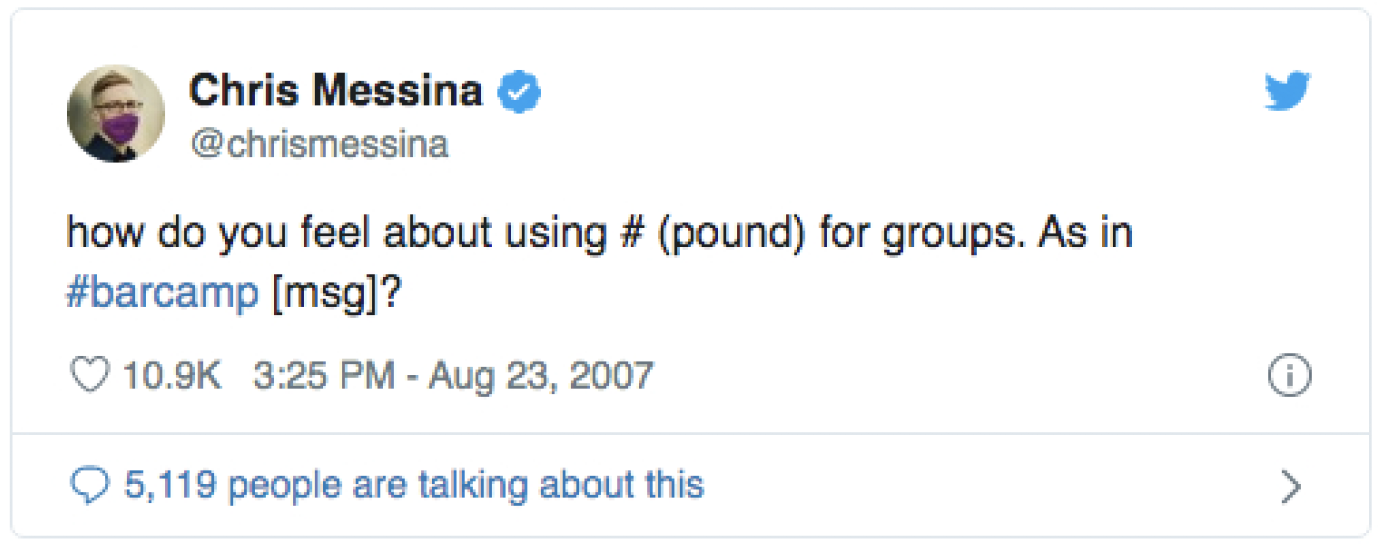Let’s talk hashtags!
Way, way back in 2007, Chris Messina essentially invented the idea of it all.

Fast forward 10 years from that tweet and we practically see the hashtag used everywhere. It’s become, by far, the best sorting tool on the internet. It allows us and our content to be found and shared.
But even with billions of hashtags in use on the top social media platforms, many people don’t know how to use them properly.
Here’s our quick guide to the dos and don’ts of hashtags.
Do this
RESEARCH
Why? Because using the correct tag not only gets you found, but it places your content in the right location to be found.
More times than not, there are multiple tags for the same topic. So which one should you use? Click on them and quickly analyze the details. One hashtag might be used by hundreds people, but another might have top accounts doing so, with hundreds upon thousands of engagements. Some quick research can go a long way in driving more traffic to yourself, your content or your brand and business.
“Twitter trends” (found on the left side of your Twitter homepage) are a great way to identify the top tags and keywords being used each day. You can sort these into “tailored trends” (based upon who you follow) or by a specific location. Just hit the “change” link beside “trends” to explore what everyone is talking about.
On Instagram, a quick way to see the popularity and usefulness of a tag is by simply typing the one you’re considering into the search field. The results that come up show you how many times it’s been used. But don’t just use any popular one—which brings me to my next point…
BE SPECIFIC
A targeted hashtag will be more engaging simply because your post won’t get lost in the masses. A post with #art might get you some likes, but a post with #OilPainting will cater to that crowd and increase your reach.
GET CREATIVE!
It’s great for branding!
North Face created the hashtag #NeverStopExploring which now has almost 10 million tagged pictures on Instagram alone. Many companies are jumping on board with this approach, as it not only creates a unique community, but drives brand awareness and sales.
USE CAPITAL LETTERS
Tags often use two-plus words, and maybe it’s a personal pet peeve, but it’s just so much clearer to read hashtags with proper capitalization. Tags aren’t case-sensitive, so why not clean things up a bit! For example, #letsbeserious makes my eyes hurt. #LetsBeSerious doesn’t.
Using capitals can also save you from some unwanted grief. Remember Susan Boyle? Well, this is what her PR team posted:

Don't do this
GET COMPLICATED
The point of a hashtag is to make things easier to find. Creating or using a hashtag which is far too long or with words that are hard to spell isn’t going to help with your reach or engagement. (Unless, of course, the tag is a joke, then the wilder the better!)
TAGS > WORDS
It looks desperate. It’s annoying. It’s overkill. It’s a faux pas.
There have been studies on this. The more hashtags you use, the less people engage with your post. Keep hashtags to a minimum. One to two specific and relevant tags is good enough and won’t cause people to lose sight of the most important part of your post: the content.
FORGET (OR ADD) SPACES
Hashtags don’t work properly when there is no space between one hashtag and the next one. #ThisWontGet#YouFar. Don’t add a space inside your hashtag, either. (On a side note, adding any punctuation inside a hashtag, such as #Let’sGoTeam, will break your hashtag.)
Of course, the best way to see if your hashtags work or not is by clicking on them. A clickable tag (on any social platform) technically means it works, but all the rules above still apply if you want it to reach the intended audience and get engagement.
#HappyHashtagging, everyone!
SHARE THIS
IN PURSUIT OF GREATNESS
12 James Street North, Suite 302
Hamilton, ON L8R 2J9
905.529.6005
hello@humancode.ca
